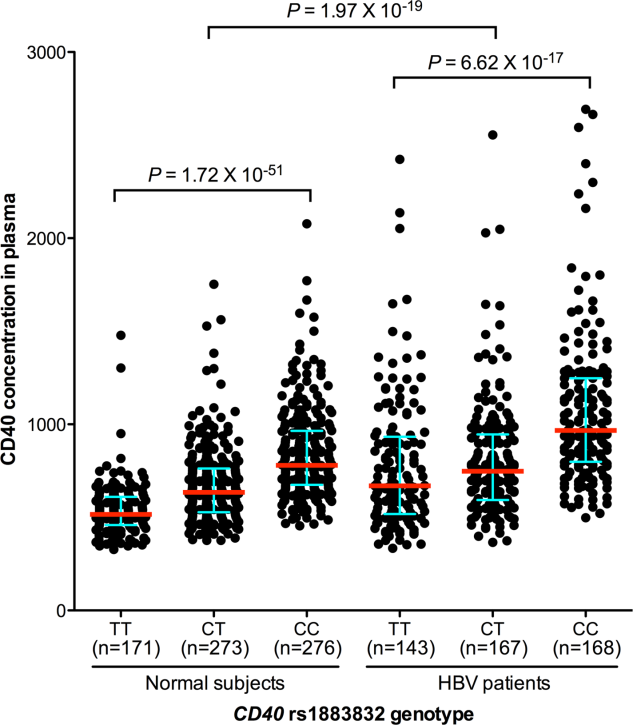Genetic variants in five novel loci including CFB and CD40 predispose to chronic hepatitis B

Hepatitis B virus affects more than 2 billion people worldwide, 350 million of which have developed chronic hepatitis B (CHB). The genetic factors that confer CHB risk are still largely unknown. We sought to identify genetic variants for CHB susceptibility in the Chinese population. We undertook a genome-wide association study (GWAS) in 2,514 CHB cases and 1,130 normal controls from eastern China. We replicated 33 of the most promising signals and eight previously reported CHB risk loci through a two-stage validation totaling 6,600 CHB cases and 8,127 controls in four independent populations, of which two populations were recruited from eastern China, one from northern China and one from southern China. The joint analyses of 9,114 CHB cases and 9,257 controls revealed significant association of CHB risk with five novel loci. Four loci are located in the human leukocyte antigen (HLA) region at 6p21.3, including two nonsynonymous variants (rs12614 [R32W] in complement factor B [CFB], Pmeta=1.28 × 10−34; and rs422951 [T320A] in NOTCH4, Pmeta = 5.33 × 10−16); one synonymous variant (rs378352 in HLA-DOA corresponding to HLA-DOA*010101, Pmeta = 1.04 × 10−23); and one noncoding variant (rs2853953 near HLA-C, Pmeta = 5.06 × 10−20). Another locus is located at 20q13.1 (rs1883832 in the Kozak sequence of CD40, Pmeta = 2.95 × 10−15). Additionally, we validated seven of eight previously reported CHB susceptibility loci (rs3130542 at HLA-C, rs1419881 at TCF19, rs652888 at EHMT2, rs2856718 at HLA-DQB1, rs7453920 at HLA-DQB2, rs3077 at HLA-DPA1, and rs9277535 at HLA-DPA2, which are all located in the HLA region, 9.84 × 10−71 ≤ Pmeta ≤ 9.92 × 10−7). Conclusion: Our GWAS identified five novel susceptibility loci for CHB. These findings improve the understanding of CHB etiology and may provide new targets for prevention and treatment of this disease. (Hepatology 2015)
《Hepatology》杂志刊发余龙教授课题组乙肝慢性化的遗传学研究成果
2015年4月28日,肝病学领域的国际顶级学术期刊《Hepatology 》杂志[IF=11.2]正式在线发表了我院余龙教授课题组的研究论文“Genetic variants in five novel loci including CFB and CD40 predispose to chronic hepatitis B”,在国际上首次揭示了乙肝慢性化的5个关键风险基因位点。
我国是乙肝大国,有1.2亿人曾经感染过乙肝病毒(HBV),其中有3000万人转化成为了慢性乙肝。近年来,随着新生儿注射乙肝疫苗的普及,新发乙肝病例在大幅下降。但是,对于现在已经存在的多达几千万之巨的慢性乙肝人群,目前尚无明确有效的药物能清除他们体内的乙肝病毒,他们将面对有可能进展为肝癌的风险。系统揭示乙肝慢性化的遗传机制,将有望找到治疗和预防乙肝慢性化的药物靶点。
我院余龙教授课题组和徐剑锋教授课题组联合了国内外20多家研究单位、40多位学者开展协作攻关,通过全基因组关联研究(GWAS)方法,对来自中国东部、北方和南方的5个独立人群的9114例慢性乙肝病人和9257例正常对照进行分析,首次鉴定到CD40、CFB等5个乙肝慢性化的关键风险基因位点。这项新发现,将促进我们对乙肝病毒感染慢性化遗传机制的理解,并为开发出有效治疗和预防乙肝的药物打下重要基础,为最终实现降低因乙肝引起的肝癌发病率的目标创造良好条件。
本研究是目前为止国际上关于乙肝慢性化的一项规模最大、研究成果最为丰硕的遗传学研究。我院的蒋德科副研究员是本论文的第一作者,余龙教授和徐剑锋教授是本论文的通讯作者,复旦大学是文章的第一单位及最终通讯单位。
